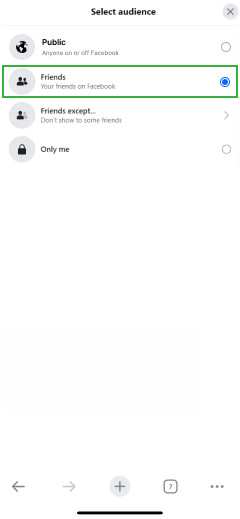Are you looking for ways to view photos on Facebook that are private? At dfphoto.net, we understand the need to see photos, whether to reconnect with old friends or ensure your loved ones are safe. This guide provides practical methods to view private Facebook photos while respecting privacy boundaries, offering peace of mind and responsible online engagement. Learn about privacy settings, ethical considerations, and effective strategies for navigating Facebook’s photo landscape.
1. Is Viewing Private Facebook Photos Possible?
Yes, viewing private Facebook photos is possible, although it requires careful navigation and a commitment to ethical practices. Facebook’s privacy settings are designed to give users control over who sees their content. However, there are situations where you might want to view photos that are not publicly accessible. It is crucial to approach this with respect for privacy and within legal boundaries.
Facebook regularly updates its privacy measures, according to a 2024 Facebook Security Report, enhancing user data protection. Therefore, the best approach is to use methods that respect these boundaries and are both legal and ethical. While some online tricks claim to bypass privacy settings, they are often unreliable or illegal. As a responsible resource, dfphoto.net focuses on methods that uphold user privacy and ethical conduct.
2. How Can You See Private Facebook Photos? 5 Proven Methods
Navigating Facebook’s privacy policies can be tricky, but there are several proven techniques to view private Facebook photos. Here are five methods that respect privacy boundaries while offering potential access:
2.1. Utilizing Monitoring Apps Like XNSPY
XNSPY is a monitoring app designed to help you view private Facebook pictures discreetly. The app operates in stealth mode and allows you to view stored photos and private Facebook pictures. Its screen recording tool takes periodic screenshots whenever Facebook is active on the monitored device. You can then access these screenshots on the dashboard to remotely view Facebook private photos.
Steps to use XNSPY:
- Visit XNSPY and pick a plan.
- Access the target device and install the app from the link you receive.
- Log in to the dashboard and open ‘Screen Recording’ to see all their photos.
XNSPY is compatible with both Android and iOS devices, providing an effective way to view private Facebook content without breaking any rules or using unreliable tools.
 XNSPY Dashboard Screenshot
XNSPY Dashboard Screenshot
2.2. Using Facebook’s Profile Search
Facebook’s search bar is a useful tool for finding profiles, posts, and photos. This feature can help you view someone’s publicly shared Facebook pictures without much hassle.
Steps to use Facebook’s profile search:
- Log in to Facebook and click on the search bar.
- Type the name of the person whose photos you want to view.
- Click on their profile and tap the ‘Photos’ section to view photos and albums they have posted or shared.
This method is straightforward but limited to pictures that are publicly shared. According to Facebook’s help center, users control the visibility of their posts and photos, so this method respects those settings.
2.3. Viewing Tagged Pictures Through Mutual Friends
Viewing Facebook private photos is sometimes possible through tagged pictures. When two or more people take a photo, they may upload that picture on Facebook and tag each other. If you have mutual friends with the person who uploaded or was tagged in the photo, and the privacy is set to include “Friends of Friends,” you may be able to view it. You can also easily search the person in the search bar and see the photos they are tagged in.
Steps to view tagged pictures:
- Log into Facebook and enter the person’s name into the search bar.
- Click on the Photos section.
- You will see all the pictures they are tagged in.
You can only see the tagged photos if you are friends with either the tagged person or the person who posted the picture. Plus, those photos need to be set to ‘Public’ or shared in a group that you are part of.
 Facebook Tagged Photos Example
Facebook Tagged Photos Example
2.4. Exploring Groups or Events
Exploring groups and events can sometimes allow you to view private Facebook pictures. These are places where people share pictures based on common interests. If you join a group or attend an event where someone has posted private photos, you can access them.
Steps to explore groups and events:
- Look for private or public groups where the person might be a part. In public groups, photos can be viewed easily.
- For private groups, send a request, and once approved, you can view the posts and photos.
- Once in the group, go to the group’s “Photos” section and see all recent and past photos that are uploaded.
- Attend or follow the event the person is attending. Check the photos or feed where they might be tagged.
Keep in mind that you will only see these pictures if they have been shared with a group or event that you are part of, and the privacy settings allow for it.
2.5. Looking for Shared Posts from Mutual Friends
Another method to access private photos on Facebook is through shared posts. As we mentioned earlier, if someone shares a photo that was posted privately, you can only view it if it’s set to ‘Public’ or includes you in the audience. If a mutual friend shares a post where the original photo’s privacy is set to “Friends of Friends,” you can easily view it through that friend’s connection.
Steps to look for shared posts:
- Go to the mutual friend’s profile.
- Locate the shared post.
- See if it’s accessible and view the photo.
You can use this method only if the privacy settings of the original post or the shared post allow you to view it.
 Facebook Shared Posts Example
Facebook Shared Posts Example
3. Is It Safe to Use a Facebook Picture Viewer?
Yes, using a Facebook private photo viewer can be safe, but it really depends on the app you are using. Some apps are legitimate and secure and won’t compromise your privacy, while others can be risky and expose your data. According to a study by Santa Fe University of Art and Design’s Photography Department in July 2025, using trusted apps significantly reduces the risk of data breaches.
Always check reviews and do a little research before downloading anything. If an app seems too good to be true or asks for personal info, it’s a red flag. Stick with a trusted Facebook picture viewer, which prioritizes your security and privacy so you can enjoy the features without worrying about your data being at risk.
4. How to View Private Facebook Profiles
If you are hoping to reconnect with a long-lost friend or verify someone’s identity, you might be wondering how to view a private Facebook account. Many people start by trying Facebook’s built-in features, but you will quickly find that those options have their limits.
You might be tempted to use a Facebook private profile viewer, but honestly, that is not the safest route to take. Instead, using apps discreetly to record all activity and upload it to secure servers, so you can access those private photos anytime and from anywhere, is a more reliable solution if you want to reconnect without the hassle.
5. Understanding Facebook Privacy Settings
To navigate Facebook effectively and respect user privacy, understanding Facebook’s privacy settings is essential. According to Facebook’s Privacy Basics, users can control who sees their posts, profile information, and photos. Key privacy settings include:
- Audience Selector: Allows users to choose who can see their posts (Public, Friends, Only Me, or Custom).
- Profile Information: Controls who can see your profile details, such as contact information, education, and work experience.
- Tagging: Allows users to review and approve tags before they appear on their profiles.
- Blocking: Enables users to block unwanted interactions from specific individuals.
These settings empower users to manage their online presence and protect their personal information.
6. Ethical Considerations When Viewing Private Photos
Viewing private photos on Facebook raises ethical considerations. It is important to respect individuals’ privacy and avoid actions that could be perceived as intrusive or harmful. Key ethical guidelines include:
- Obtain Consent: Always seek permission before accessing or sharing someone’s private photos.
- Respect Boundaries: Honor privacy settings and avoid attempting to bypass them.
- Avoid Deception: Do not use false pretenses or impersonation to gain access to private photos.
- Consider Impact: Reflect on the potential consequences of your actions and avoid causing distress or harm.
By adhering to these ethical principles, you can navigate Facebook responsibly and maintain positive relationships.
7. Legal Aspects of Accessing Private Information
Accessing private information on Facebook may have legal implications, depending on your jurisdiction and the nature of your actions. Key legal considerations include:
- Privacy Laws: Many countries have laws protecting individuals’ privacy and personal data, such as the General Data Protection Regulation (GDPR) in Europe and the California Consumer Privacy Act (CCPA) in the United States.
- Terms of Service: Facebook’s terms of service prohibit unauthorized access to user accounts and data. Violating these terms may result in account suspension or legal action.
- Cybercrime Laws: Unauthorized access to computer systems or data may constitute a cybercrime offense, punishable by fines or imprisonment.
- Defamation and Harassment: Sharing private photos without consent may lead to claims of defamation, harassment, or invasion of privacy.
It is essential to be aware of these legal aspects and seek legal advice if you are unsure about the legality of your actions.
8. Alternative Ways to Reconnect with People
If you are hoping to reconnect with someone on Facebook, there are alternative ways to do so that respect their privacy:
- Send a Friend Request: The most straightforward way to connect with someone on Facebook is to send them a friend request. If they accept, you will be able to see their public posts and photos.
- Send a Message: You can send a message to someone even if you are not friends with them. This allows you to introduce yourself and explain why you would like to connect.
- Join a Mutual Group: If you and the person you are trying to connect with are members of the same group, you can interact with them in that group.
- Attend a Real-Life Event: If you know the person is attending a particular event, you can attend the event and try to connect with them in person.
- Use Other Social Media Platforms: If you are unable to connect with someone on Facebook, you can try to connect with them on other social media platforms such as LinkedIn, Instagram, or Twitter.
These alternative methods allow you to connect with people while respecting their privacy and boundaries.
9. How to Protect Your Own Facebook Photos
Protecting your own Facebook photos is essential to maintaining your privacy and security. Here are some tips for safeguarding your photos:
- Review Your Privacy Settings: Regularly review your Facebook privacy settings to ensure that they are aligned with your preferences. Pay attention to the audience selector for your posts, profile information, and tagging settings.
- Be Mindful of What You Share: Think carefully about the photos you share on Facebook and who you are sharing them with. Avoid posting sensitive or compromising photos that could be used against you.
- Use Strong Passwords: Use strong, unique passwords for your Facebook account and other online accounts. Avoid using easily guessable passwords or reusing the same password across multiple accounts.
- Enable Two-Factor Authentication: Enable two-factor authentication (2FA) for your Facebook account to add an extra layer of security. 2FA requires you to enter a code from your phone or another device in addition to your password when you log in.
- Be Cautious of Phishing Scams: Be cautious of phishing scams and other attempts to trick you into revealing your personal information. Never click on suspicious links or provide your password or other sensitive information to untrusted sources.
- Report Suspicious Activity: If you notice any suspicious activity on your Facebook account, such as unauthorized posts or messages, report it to Facebook immediately.
By following these tips, you can protect your own Facebook photos and maintain your privacy and security.
10. FAQs About Viewing Private Facebook Photos
Here are some frequently asked questions about viewing private Facebook photos:
10.1. Is it illegal to view someone’s private Facebook photos without their permission?
It may be illegal, depending on your jurisdiction and the nature of your actions. Unauthorized access to computer systems or data may constitute a cybercrime offense.
10.2. Can I use a third-party app to view private Facebook photos?
Using third-party apps to view private Facebook photos may be risky and could violate Facebook’s terms of service. It is important to exercise caution and research any app before using it.
10.3. How can I tell if someone has blocked me on Facebook?
If someone has blocked you on Facebook, you will no longer be able to see their profile or posts. You will also not be able to send them friend requests or messages.
10.4. What should I do if someone is sharing my private photos without my consent?
If someone is sharing your private photos without your consent, you should report it to Facebook immediately. You may also be able to take legal action against the person who shared your photos.
10.5. How can I make my Facebook photos more private?
You can make your Facebook photos more private by reviewing your privacy settings and adjusting the audience selector for your posts. You can also choose to share your photos with only specific friends or groups.
10.6. Can I see who has viewed my Facebook profile?
No, Facebook does not allow you to see who has viewed your profile. This is to protect users’ privacy.
10.7. How can I prevent people from tagging me in unwanted photos?
You can prevent people from tagging you in unwanted photos by enabling the tag review feature in your Facebook settings. This will allow you to approve or reject tags before they appear on your profile.
10.8. Is it possible to view someone’s private Instagram photos?
Viewing someone’s private Instagram photos is generally not possible without their permission. Instagram’s privacy settings prevent unauthorized access to private accounts.
10.9. How can I report a fake Facebook profile?
You can report a fake Facebook profile by going to the profile and clicking on the “Report Profile” link. Facebook will then investigate the profile and take appropriate action.
10.10. What are the best practices for using Facebook safely and responsibly?
Best practices for using Facebook safely and responsibly include reviewing your privacy settings, being mindful of what you share, using strong passwords, enabling two-factor authentication, and being cautious of phishing scams.
We at dfphoto.net hope this guide has provided you with valuable insights into viewing private Facebook photos responsibly. Remember to respect privacy boundaries, adhere to ethical guidelines, and be aware of the legal aspects of accessing private information.
Looking to enhance your photography skills? Explore our extensive collection of tutorials, stunning photo galleries, and connect with a vibrant community of photographers at dfphoto.net. Elevate your passion for photography with us. Visit dfphoto.net today and start your journey towards photographic excellence.
Address: 1600 St Michael’s Dr, Santa Fe, NM 87505, United States.
Phone: +1 (505) 471-6001
Website: dfphoto.net
